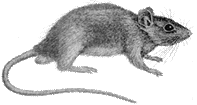How to recognize whether you have a Roof Rat in the house
Roof Rat Description
A Roof Rat is a blackish (or brownish), medium-sized, slender rat with long, naked, scaly tail; tail usually longer than head and body but not always so. External measurements average: total length, 370 mm; tail, 190 mm; hind foot, 36 mm., weight, up to 200 g.
 A roof rat is largely commensal and lives in close association with man. They seldom become established as feral animals as do the Norway rats. In Lavaca County, as an example, they have been found throughout the county, in the towns, and on the farms.
A roof rat is largely commensal and lives in close association with man. They seldom become established as feral animals as do the Norway rats. In Lavaca County, as an example, they have been found throughout the county, in the towns, and on the farms.
They inhabited grocery and drug stores, warehouses, feed stores, and poultry houses. They were very common in cotton gins and associated grain warehouses. On the farms they lived in barns and corn cribs. They may live near the ground, but usually they frequent the attics, rafters, and crossbeams of the buildings.
Roof Rats Can Move Around Easily
They make typical runways along pipes, beams or wires, up and down the studding, or along the horizontal ceiling joists. They often leave a dark-colored layer of grease and dirt to mark their travel ways. Like the Norway rat, the roof rat is largely nocturnal and only where populations are relatively high does one see them frequently in the daytime. There is some indication that the larger and more aggressive Norway rat is supplanting the roof rat in many parts of the United States. In the southern United States, however, the roof rat is by far the more common of the two.
They accept a wide variety of food items, including grains, meats, and almost any item that has nutritive value.
Roof Rat Breeding
Roof rats breed throughout the year, with two peaks of production in February and March and again in May and June. The period of least activity is in July and August. The gestation period is approximately 21 days, and the number of young per litter averages almost seven. The young rats at birth are naked, blind, and nearly helpless. They mature rather rapidly, are weaned when about 3 weeks old, and are able to reproduce when approximately 3 months old. In Texas, young females with a head and body length of 125 mm were sexually mature. Like the Norway rat, the roof rat is destructive to property and foodstuffs. Also, it plays an important part in the transmission of such human diseases as endemic typhus, rat bite fever, and bubonic plague.